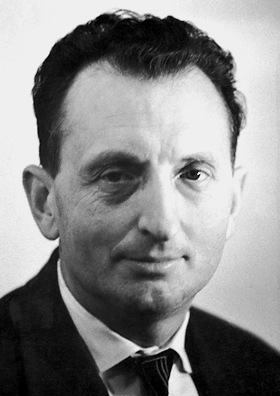Aleksandr M. Prokhorov
Aleksandr M. Prokhorov

Source: Photograph by O. Kuzmin, courtesy of AIP Emilio Segrè Visual Archives, Physics Today Collection
Nobel Laureate and OSA Honorary Member Aleksandr Mikhailovich Prokhorov was born 11 July 1916 in Australia. He and his parents returned to Russia in 1923 and nearly a decade later Prokhorov entered the Physics Department of the Leningrad State University. He attended lectures of on quantum mechanics, the theory of relativity, general physics and spectroscopy, and molecular physics. After graduating in 1939 he went on to the P.N. Lebedev Physical Institute in Moscow, to study in radio wave propagation. In June 1941, he was mobilized in the Red Army. He took part in World War II and was wounded twice. After his second injury Prokhorov went back to the Lebedev Institute where he began to investigate nonlinear oscillations.
In 1946 he defended his thesis which dealt with the theory of stabilization of frequency of a tube oscillator in the theory of a small parameter. The following year Prokhorov carried out a study of the coherent radiation of electrons in the synchrotron in the region of centimeter waves. As a result of these investigations he wrote and defended his Ph.D. thesis concerning coherent radiation of electrons in the synchrotron accelerator. Prokhorov also began investigating radiospectroscopy and, later, quantum electronics.
The investigations carried out by N.G. Basov and Prokhorov in the field of microwave spectroscopy resulted in the idea of a molecular oscillator. They developed a theoretical basis for creation of a molecular oscillator and also constructed a molecular oscillator operating on ammonia. In 1955, Basov and Prokhorov proposed a method for the production of a negative absorption which was called the pumping method.
The same year Prokhorov began to research electronic paramagnetic resonance (EPR). A cycle of investigations of EPR spectra and relaxation times in various crystals was carried out, in particular investigations on ions of the iron group elements in the lattice of Al2O3.
Prokhorov and A.A. Manenkov studied the EPR spectra of ruby that made it possible to suggest the crystal as a material for lasers in 1957. They designed and constructed masers using various materials and studied characteristics of the masers as well. This research was done in cooperation with the laboratory of radiospectroscopy of the Institute of Nuclear Physics of the Moscow University. The EPR methods were also utilized for the study of free radicals.
In 1958 Prokhorov suggested a laser for generation of infrared waves. As a resonator it was proposed to use a new type of cavity which was later called "the cavity of an open type". In practice the cavity was a Fabry-Perot interferometer. Later, Prokhorov became interested in solid lasers and their application to study multi-quantum processes.
Prokhorov received a number of awards and honors for his work including the Nobel Prize in Physics in 1964 for his pioneering work on masers and lasers, the Lenin Prize, the Demidov Prize and OSA’s Frederic Ives Medal. He was a member of the Russian Academy of Sciences and the American Academy of Sciences.
In 2001, he was named an Honorary Member of the Optical Society for his distinguished contributions and monumental role over the past 45 years in creating and developing quantum electronics
Prokhorov died in 2002.
Document Created: 26 July 2023
Last Updated: 18 July 2025
